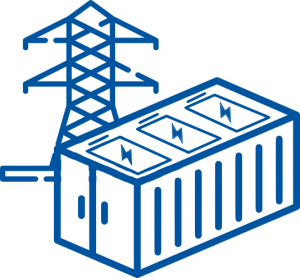


Home Storage Capacity
Industrial Storage Capacity
Large-Scale Storage Capacity
Currently installed and in operation home storage battery energy capacity in Germany
Currently installed and in operation industrial storage battery energy capacity in Germany
Installed and in operation battery energy capacity of large-scale storages in Germany
About Battery Charts
Battery Charts is a development by Dr. Jan Figgener, Dr. Christopher Hecht, Jonas Brucksch, Jonas van Ouwerkerk, and Prof. Dirk Uwe Sauer from the Institutes ISEA and PGS at RWTH Aachen University. The maintenance and further development of Battery Charts is done by Jonas Brucksch, Lucas Koltermann and Daniel Dang. With this website, we offer an automated evaluation of battery storage from the public database (MaStR) of the German Federal Network Agency. For simplicity’s sake, we divide the battery storage market into:
- Home storage systems: < 30 kWh AND < 30 kW
- Industrial storage systems: < 1000 kWh AND < 1000 kW
- Large-scale storage systems: ≥ 1000 kWh OR ≥ 1000 kW
kWh: kilowatt hours; kW: kilowatts
This page is the supplementary material of the detailed market analysis in our current publication. The graphics and data on this page are licensed under CC BY 4.0 and may be used with credit to the authors and license (see „About Us” tab).
Battery Energy
In total, some gigawatt hours of stationary battery storage is reported by now in Germany. The largest share of this is accounted for by home storage, which carries the overall market. Large-scale storage forms the second largest market ahead of industrial storage. For comparison: The national pumped-hydro storage systems have a total energy of 39 gigawatt hours.
Home storage systems are currently mainly used to increase solar self-consumption. Industrial storage systems are primarily used for solar self-consumption as well as peak shaving for businesses or fast charging of electric vehicles. In recent years, large-scale battery storage systems have been built almost exclusively to provide primary control power. Currently, however, three new areas of application are emerging:
- Arbitrage trading on spot markets
- Integration of large PV and wind farms
- Grid booster projects for grid operation management
- Optimization of energy management at large industrial sites
Battery Power
Battery storage systems in most cases offer the possibility to be charged or discharged for more than one hour at full power. The total power is a few gigawatts. The power is distributed roughly in proportion to the storage energy.
Number of Installations
Now, hundreds of thousands of storage systems are registered with the Federal Network Agency. In terms of numbers, these are almost exclusively home storage systems. However, the number of industrial storage systems is also increasing significantly, with few thousand registrations, which can be seen by clicking on the legend. The number of large-scale battery storage systems is way lower. It should be noted that individual registrations with storage energy of over 1,000 kWh are filtered out, as these are often unverified entries in which private individuals mistakenly register storage systems in the megawatt class.
Addition of Batteries
In addition to the cumulative presentation of the storage energy, the monthly additions are also shown. It is easy to see that the trend in new installations is clearly increasing. The current developments of rising electricity prices and the war in Ukraine strengthen the desires for self-sufficiency and for an own PV system including battery storage.In addition to the cumulative presentation of the storage energy, the monthly additions are also shown. It is easy to see that the trend in new installations is clearly increasing. The current developments of rising electricity prices and the war in Ukraine strengthen the desires for self-sufficiency and for an own PV system including battery storage.
Battery Technologies
At the beginning of the home storage market, lead-acid and lithium-ion batteries had the highest market shares. Over time, however, lithium-ion batteries have clearly gained market shares and have taken up almost the entire market in recent years.
The commercial storage market also features a majority of lithium-ion batteries. It should be noted, however, that systems for uninterruptible power supply are not subject to registration in all cases and lead-acid batteries are still frequently used here.
The variety of technologies in the large-scale storage market was greatest in the early years of the storage market. In addition to lead-acid and lithium-ion batteries, high-temperature and redox-flow batteries also exist here. Today’s new installations, however, are also predominantly lithium-ion based.
Planned Battery Storage Systems
The MaStR also includes planned battery storage systems in part. The majority is accounted for by large-scale storage systems. This is mainly due to the fact that the smaller home storage systems and industrial storage systems are often not reported until they are installed.
Regional Distribution
Home Storage
Regional Distribution by County
Industrial Storage
Regional Distribution by County
Large-Scale Battery Storage
Regional Distribution
The storage systems are distributed throughout Germany. While home storage and industrial storage are aggregated within districts, large-scale storage is presented as individual systems. For home and industrial storage, most of the systems are in the western and southern parts of Germany. On the other hand, the large-scale storage systems do not show a clear distribution.
Ranking Large-Scale Storages
coming soon
Energy to Power Ratio
The energy-to-power ratio (EPR) indicates the energy capacity installed in relation to the power of the battery storage system. This ratio is also referred to as storage duration, which means that a 2-hour storage system takes approximately 2 hours to fully discharge. For home storage systems, the EPR has fallen from approximately 2 hours to 1.7 hours in recent years. The EPR for industrial storage systems has remained stable at approximately 1.5 hours. In the area of large-scale storage, however, there has been a significant increase in the EPR from 1 hour to 2 hours and beyond. The reason for the increase in EPR for large-scale storage systems is that in the past they were used for grid services such as FCR, and now large-scale battery storage systems are increasingly being used in the wholesale market and the aFRR market. For these markets, larger EPRs are advantageous and enable higher revenues.
Large-Scale Battery Storage Announcements
coming soon
Methodology
This website visualizes the MaStR data of the German Federal Netword Agency. The data are available under license dl-en/by-2-0 at the website of the German Federal Network Agency https://www.marktstammdatenregister.de/MaStR. The analyses are based on our own evaluations of the published individual registrations, which are performed to the best of our knowledge.
The graphics are interactive and can be adjusted by clicking on the legend (click: single view | click + Ctrl: select multiple data series). In addition to the selection on this page, there is also a publicly accessible dashboard (link to Grafana) that allows you to select individual federal states and battery technologies.
The data in MaStR is entered manually by individuals, and incorrect entries occur from time to time. We therefore take the following steps to clean up the data:
1) Consistency filter
Only entries with storage capacity (> 0.3 kWh), power (>0.3 kW), defined battery technology (including ‘Other’) and a valid commissioning date are considered.
The charging or discharging time under full load (energy-to-power ratio) must be between 6 minutes and 12 hours.
2) Categorisation
- Classification into market segments according to the following conditions
- Home storage systems: < 30 kWh AND < 30 kW
- Industrial storage systems: a) (Exclusive) EITHER < 30 kWh OR < 30 kW b) < 1000 kWh AND < 1000 kWh
- Large-scale storage systems: ≥ 1000 kWh AND ≥ 1000 kWh
- Large storages may not be operated by private individuals, as there is often confusion between kilowatts and watts and private individuals sometimes incorrectly state that they own a megawatt-class storage system.
- In addition, the grid connection of large storage facilities to the low-voltage grid is only accepted if the grid operator has already checked the entry.
3) Correction
All entries sorted out in steps 1) and 2) are then manually added to the statistics. If the entry was made by a natural person, it is assumed that it is a home storage system . If not, we categorise the entry as a industrial storage facility, because we assume that large storage systems are always entered correctly. The corrected entries are dimensioned using the average power and capacity in the respective month of entry for the respective category.
This filtering and correction process enables us to ensure that every registered storage facility is also reflected in our statistics and that there are no more grossly incorrect entries.
In our estimation, the completeness of the MaStR is now very high for new installations. Although many battery storage systems were not subsequently registered after the MaStR came into operation (this applies to installations prior to 2019), the number of installations in those years was not particularly high. For new installations, we assume a non-reporting rate of a few percent from 2021 onwards.
We present the battery storage systems according to their commissioning date and not their registration date. This means that the figures for the last 2-3 months in particular will rise slightly, as registration does not always take place immediately.










